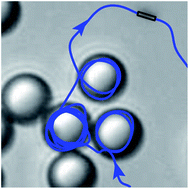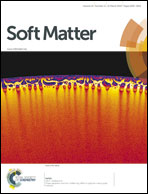Hydrodynamic capture of microswimmers into sphere-bound orbits†
Abstract
Self-propelled particles can exhibit surprising non-equilibrium behaviors, and how they interact with obstacles or boundaries remains an important open problem. Here we show that chemically propelled micro-rods can be captured, with little change in their speed, into close orbits around solid spheres resting on or near a horizontal plane. We show that this interaction between sphere and particle is short-range, occurring even for spheres smaller than the particle length, and for a variety of sphere materials. We consider a simple model, based on lubrication theory, of a force- and torque-free swimmer driven by a surface slip (the phoretic propulsion mechanism) and moving near a solid surface. The model demonstrates capture, or movement towards the surface, and yields speeds independent of distance. This study reveals the crucial aspects of activity–driven interactions of self-propelled particles with passive objects, and brings into question the use of colloidal tracers as probes of active matter.


 Please wait while we load your content...
Please wait while we load your content...